Analysis of Asset Management in Water Supply Networks: DEWA Case Study
VerifiedAdded on 2020/03/16
|35
|6640
|473
Report
AI Summary
This report delves into the critical aspects of asset management within water supply networks, emphasizing the importance of effective decision-making processes. It explores the structural formulation, asset inventory, and cost strategies involved in managing such systems, using the Dubai Electricity and Water Authority (DEWA) as a case study. The report examines key elements like asset design, reliability in operations, assessment, maintenance, and replacement, alongside strategic drivers and the application of standards such as PAS 55 and ISO 55000. It analyzes both internal and external factors influencing asset management, including cost considerations and competitive advantages. Furthermore, it discusses frameworks for asset management, key asset-related activities, and the development of an asset management strategy, with recommendations for improvement. The report highlights the benefits of an integrated approach, including improved asset life, consumer satisfaction, and efficient operational activities.
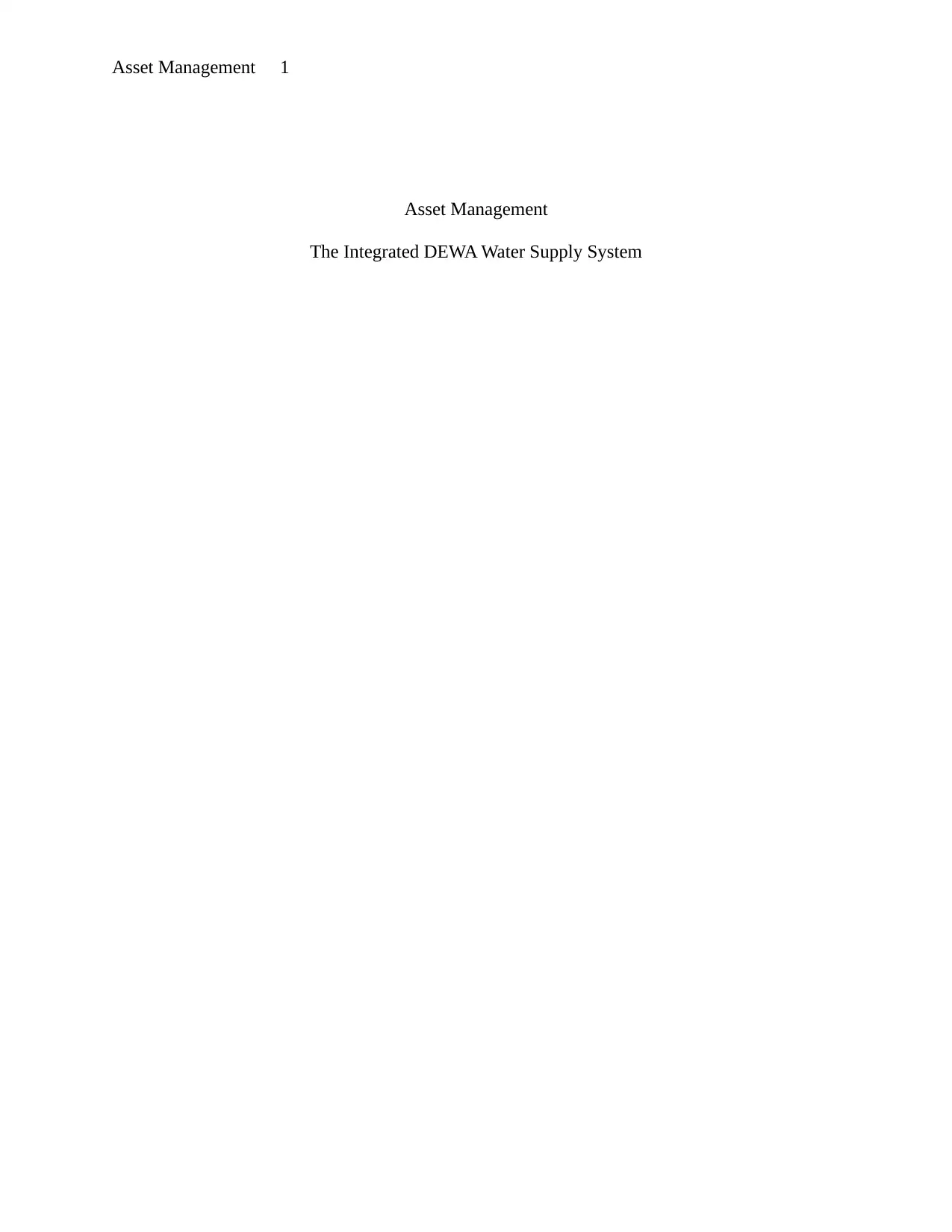
Asset Management 1
Asset Management
The Integrated DEWA Water Supply System
Asset Management
The Integrated DEWA Water Supply System
Paraphrase This Document
Need a fresh take? Get an instant paraphrase of this document with our AI Paraphraser
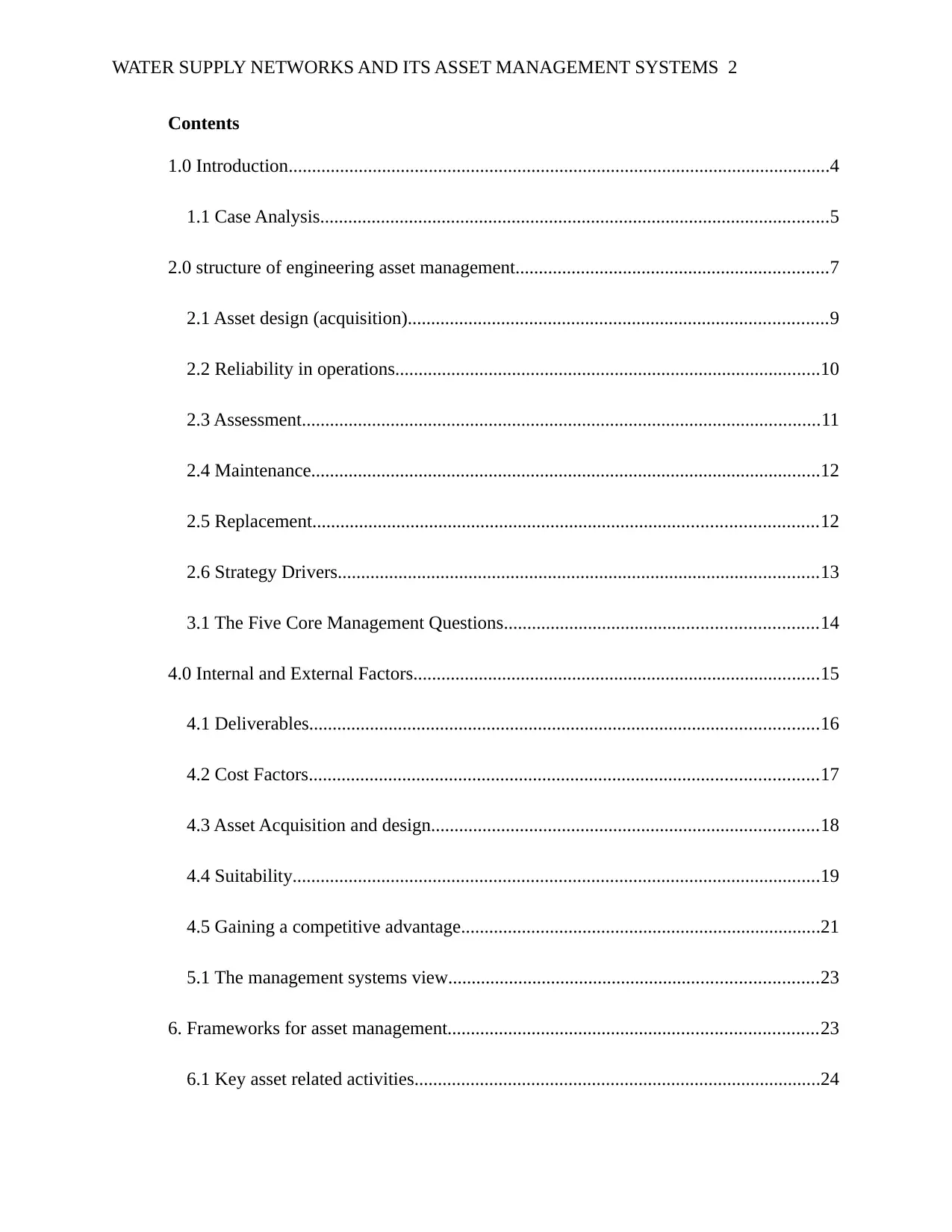
WATER SUPPLY NETWORKS AND ITS ASSET MANAGEMENT SYSTEMS 2
Contents
1.0 Introduction....................................................................................................................4
1.1 Case Analysis.............................................................................................................5
2.0 structure of engineering asset management...................................................................7
2.1 Asset design (acquisition)..........................................................................................9
2.2 Reliability in operations...........................................................................................10
2.3 Assessment...............................................................................................................11
2.4 Maintenance.............................................................................................................12
2.5 Replacement............................................................................................................12
2.6 Strategy Drivers.......................................................................................................13
3.1 The Five Core Management Questions...................................................................14
4.0 Internal and External Factors.......................................................................................15
4.1 Deliverables.............................................................................................................16
4.2 Cost Factors.............................................................................................................17
4.3 Asset Acquisition and design...................................................................................18
4.4 Suitability.................................................................................................................19
4.5 Gaining a competitive advantage.............................................................................21
5.1 The management systems view...............................................................................23
6. Frameworks for asset management...............................................................................23
6.1 Key asset related activities.......................................................................................24
Contents
1.0 Introduction....................................................................................................................4
1.1 Case Analysis.............................................................................................................5
2.0 structure of engineering asset management...................................................................7
2.1 Asset design (acquisition)..........................................................................................9
2.2 Reliability in operations...........................................................................................10
2.3 Assessment...............................................................................................................11
2.4 Maintenance.............................................................................................................12
2.5 Replacement............................................................................................................12
2.6 Strategy Drivers.......................................................................................................13
3.1 The Five Core Management Questions...................................................................14
4.0 Internal and External Factors.......................................................................................15
4.1 Deliverables.............................................................................................................16
4.2 Cost Factors.............................................................................................................17
4.3 Asset Acquisition and design...................................................................................18
4.4 Suitability.................................................................................................................19
4.5 Gaining a competitive advantage.............................................................................21
5.1 The management systems view...............................................................................23
6. Frameworks for asset management...............................................................................23
6.1 Key asset related activities.......................................................................................24
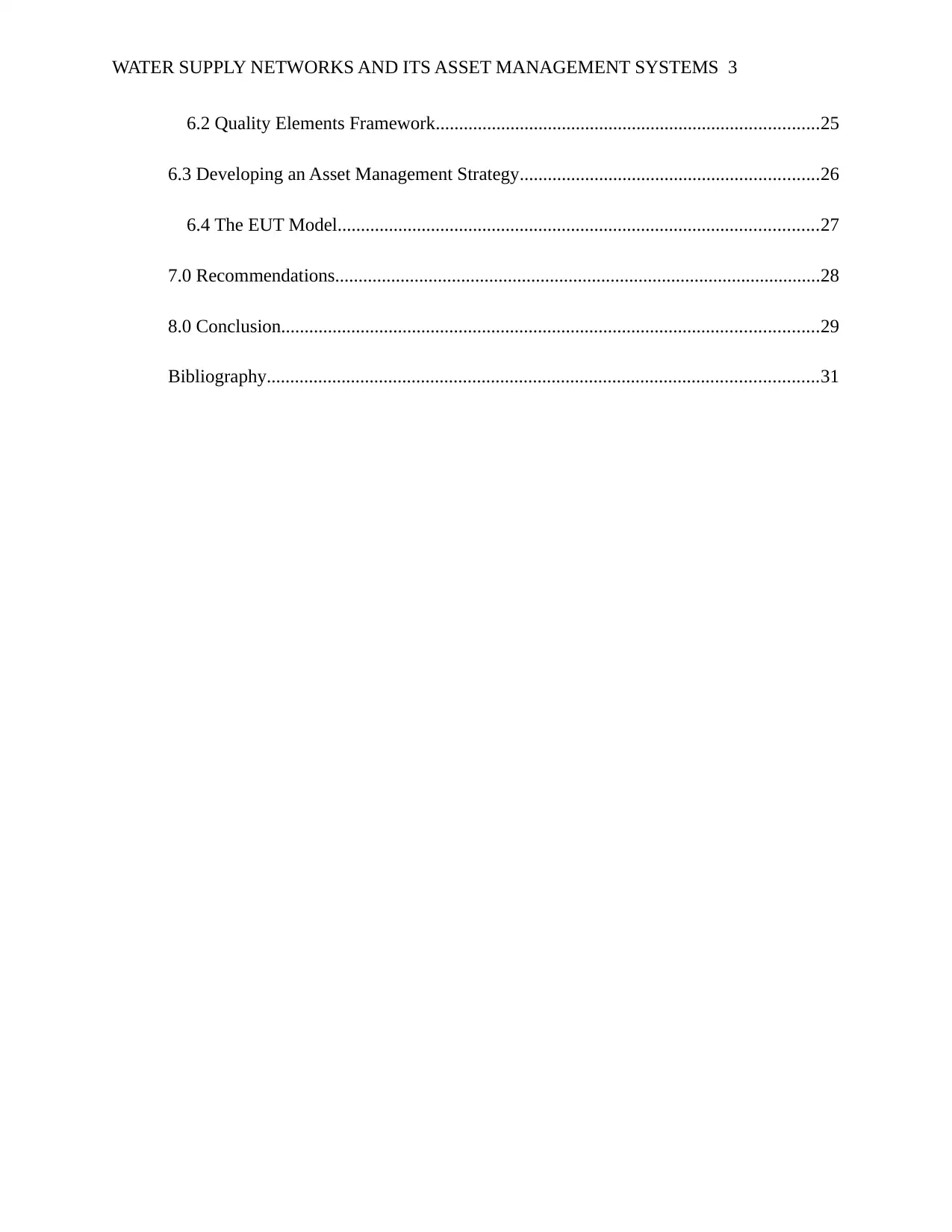
WATER SUPPLY NETWORKS AND ITS ASSET MANAGEMENT SYSTEMS 3
6.2 Quality Elements Framework..................................................................................25
6.3 Developing an Asset Management Strategy................................................................26
6.4 The EUT Model.......................................................................................................27
7.0 Recommendations........................................................................................................28
8.0 Conclusion...................................................................................................................29
Bibliography......................................................................................................................31
6.2 Quality Elements Framework..................................................................................25
6.3 Developing an Asset Management Strategy................................................................26
6.4 The EUT Model.......................................................................................................27
7.0 Recommendations........................................................................................................28
8.0 Conclusion...................................................................................................................29
Bibliography......................................................................................................................31
⊘ This is a preview!⊘
Do you want full access?
Subscribe today to unlock all pages.

Trusted by 1+ million students worldwide
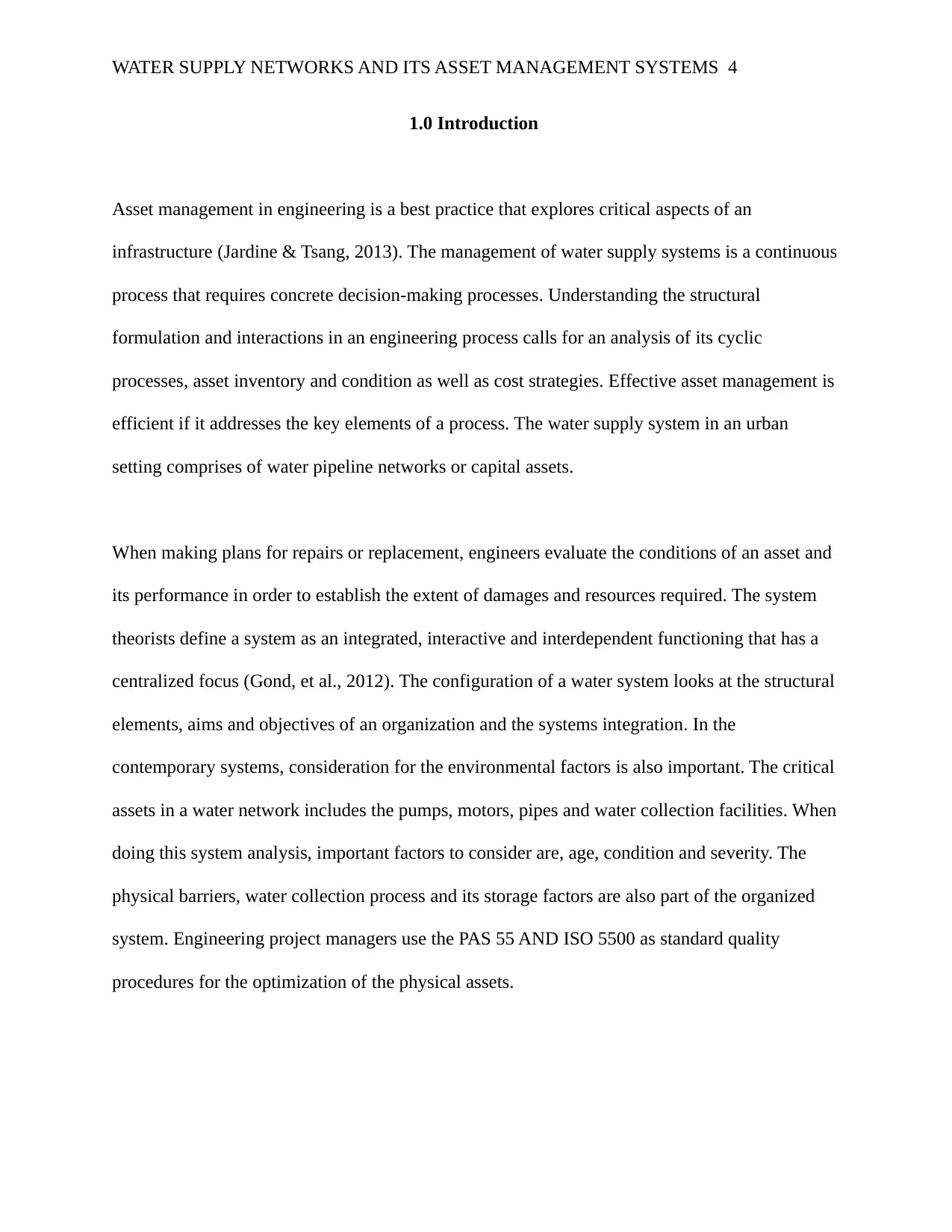
WATER SUPPLY NETWORKS AND ITS ASSET MANAGEMENT SYSTEMS 4
1.0 Introduction
Asset management in engineering is a best practice that explores critical aspects of an
infrastructure (Jardine & Tsang, 2013). The management of water supply systems is a continuous
process that requires concrete decision-making processes. Understanding the structural
formulation and interactions in an engineering process calls for an analysis of its cyclic
processes, asset inventory and condition as well as cost strategies. Effective asset management is
efficient if it addresses the key elements of a process. The water supply system in an urban
setting comprises of water pipeline networks or capital assets.
When making plans for repairs or replacement, engineers evaluate the conditions of an asset and
its performance in order to establish the extent of damages and resources required. The system
theorists define a system as an integrated, interactive and interdependent functioning that has a
centralized focus (Gond, et al., 2012). The configuration of a water system looks at the structural
elements, aims and objectives of an organization and the systems integration. In the
contemporary systems, consideration for the environmental factors is also important. The critical
assets in a water network includes the pumps, motors, pipes and water collection facilities. When
doing this system analysis, important factors to consider are, age, condition and severity. The
physical barriers, water collection process and its storage factors are also part of the organized
system. Engineering project managers use the PAS 55 AND ISO 5500 as standard quality
procedures for the optimization of the physical assets.
1.0 Introduction
Asset management in engineering is a best practice that explores critical aspects of an
infrastructure (Jardine & Tsang, 2013). The management of water supply systems is a continuous
process that requires concrete decision-making processes. Understanding the structural
formulation and interactions in an engineering process calls for an analysis of its cyclic
processes, asset inventory and condition as well as cost strategies. Effective asset management is
efficient if it addresses the key elements of a process. The water supply system in an urban
setting comprises of water pipeline networks or capital assets.
When making plans for repairs or replacement, engineers evaluate the conditions of an asset and
its performance in order to establish the extent of damages and resources required. The system
theorists define a system as an integrated, interactive and interdependent functioning that has a
centralized focus (Gond, et al., 2012). The configuration of a water system looks at the structural
elements, aims and objectives of an organization and the systems integration. In the
contemporary systems, consideration for the environmental factors is also important. The critical
assets in a water network includes the pumps, motors, pipes and water collection facilities. When
doing this system analysis, important factors to consider are, age, condition and severity. The
physical barriers, water collection process and its storage factors are also part of the organized
system. Engineering project managers use the PAS 55 AND ISO 5500 as standard quality
procedures for the optimization of the physical assets.
Paraphrase This Document
Need a fresh take? Get an instant paraphrase of this document with our AI Paraphraser
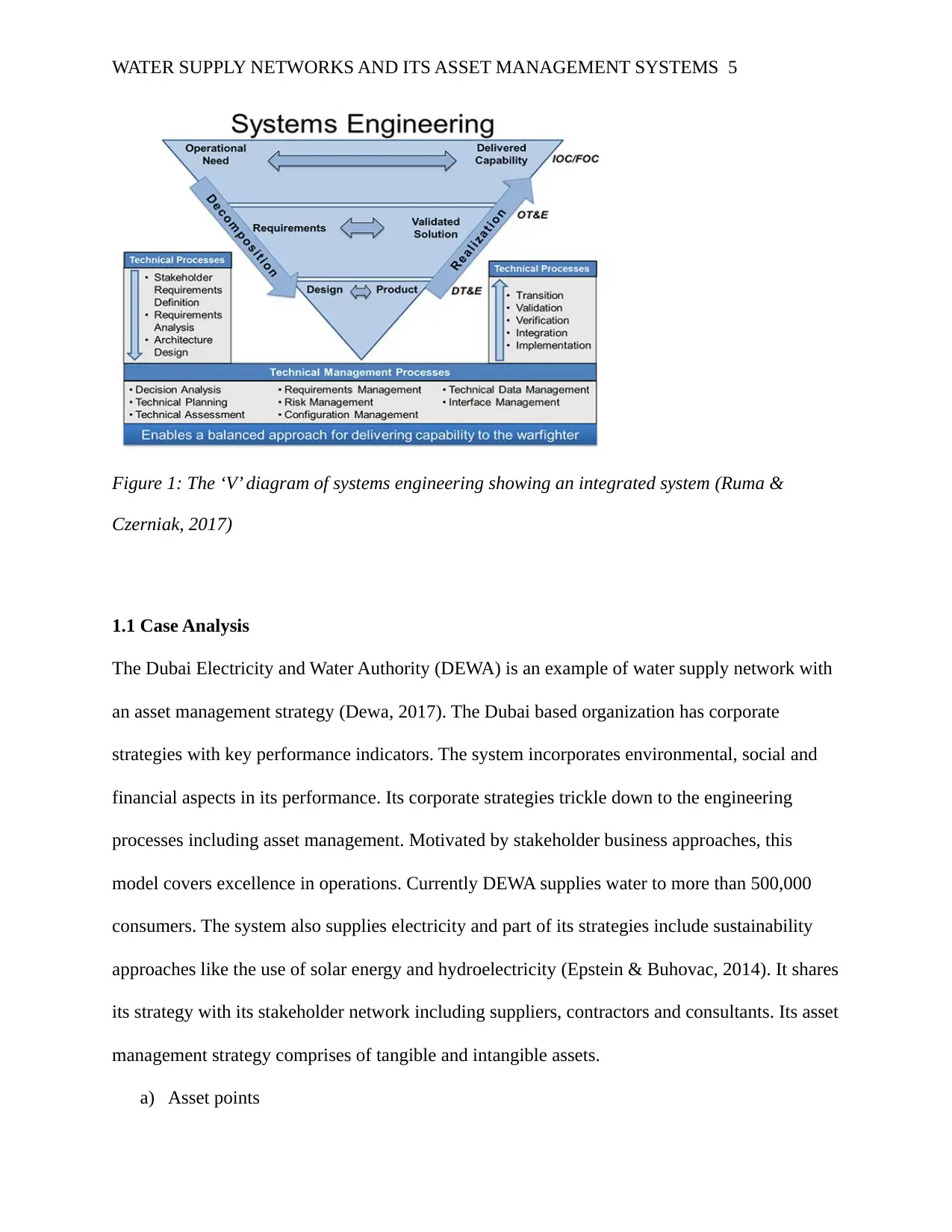
WATER SUPPLY NETWORKS AND ITS ASSET MANAGEMENT SYSTEMS 5
Figure 1: The ‘V’ diagram of systems engineering showing an integrated system (Ruma &
Czerniak, 2017)
1.1 Case Analysis
The Dubai Electricity and Water Authority (DEWA) is an example of water supply network with
an asset management strategy (Dewa, 2017). The Dubai based organization has corporate
strategies with key performance indicators. The system incorporates environmental, social and
financial aspects in its performance. Its corporate strategies trickle down to the engineering
processes including asset management. Motivated by stakeholder business approaches, this
model covers excellence in operations. Currently DEWA supplies water to more than 500,000
consumers. The system also supplies electricity and part of its strategies include sustainability
approaches like the use of solar energy and hydroelectricity (Epstein & Buhovac, 2014). It shares
its strategy with its stakeholder network including suppliers, contractors and consultants. Its asset
management strategy comprises of tangible and intangible assets.
a) Asset points
Figure 1: The ‘V’ diagram of systems engineering showing an integrated system (Ruma &
Czerniak, 2017)
1.1 Case Analysis
The Dubai Electricity and Water Authority (DEWA) is an example of water supply network with
an asset management strategy (Dewa, 2017). The Dubai based organization has corporate
strategies with key performance indicators. The system incorporates environmental, social and
financial aspects in its performance. Its corporate strategies trickle down to the engineering
processes including asset management. Motivated by stakeholder business approaches, this
model covers excellence in operations. Currently DEWA supplies water to more than 500,000
consumers. The system also supplies electricity and part of its strategies include sustainability
approaches like the use of solar energy and hydroelectricity (Epstein & Buhovac, 2014). It shares
its strategy with its stakeholder network including suppliers, contractors and consultants. Its asset
management strategy comprises of tangible and intangible assets.
a) Asset points
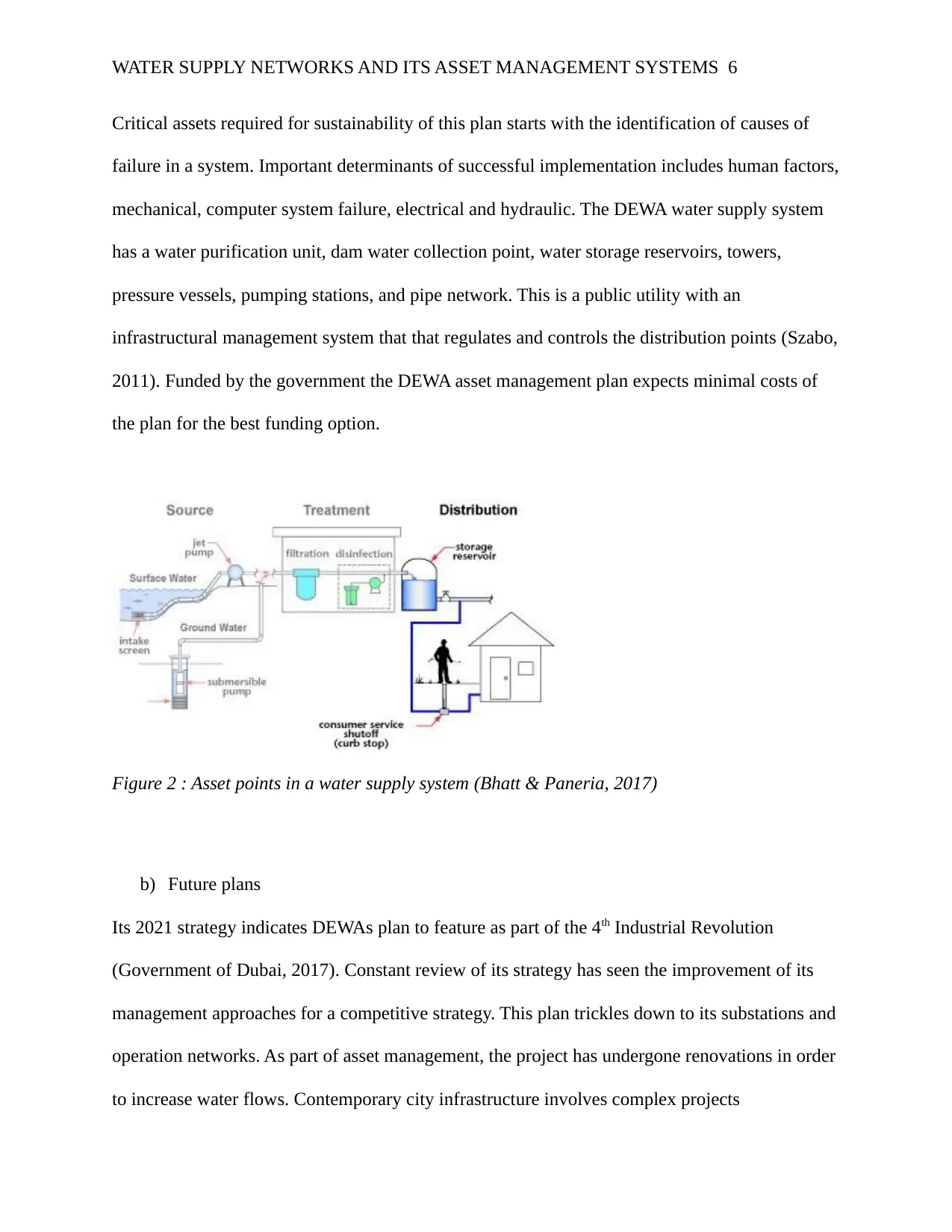
WATER SUPPLY NETWORKS AND ITS ASSET MANAGEMENT SYSTEMS 6
Critical assets required for sustainability of this plan starts with the identification of causes of
failure in a system. Important determinants of successful implementation includes human factors,
mechanical, computer system failure, electrical and hydraulic. The DEWA water supply system
has a water purification unit, dam water collection point, water storage reservoirs, towers,
pressure vessels, pumping stations, and pipe network. This is a public utility with an
infrastructural management system that that regulates and controls the distribution points (Szabo,
2011). Funded by the government the DEWA asset management plan expects minimal costs of
the plan for the best funding option.
Figure 2 : Asset points in a water supply system (Bhatt & Paneria, 2017)
b) Future plans
Its 2021 strategy indicates DEWAs plan to feature as part of the 4th Industrial Revolution
(Government of Dubai, 2017). Constant review of its strategy has seen the improvement of its
management approaches for a competitive strategy. This plan trickles down to its substations and
operation networks. As part of asset management, the project has undergone renovations in order
to increase water flows. Contemporary city infrastructure involves complex projects
Critical assets required for sustainability of this plan starts with the identification of causes of
failure in a system. Important determinants of successful implementation includes human factors,
mechanical, computer system failure, electrical and hydraulic. The DEWA water supply system
has a water purification unit, dam water collection point, water storage reservoirs, towers,
pressure vessels, pumping stations, and pipe network. This is a public utility with an
infrastructural management system that that regulates and controls the distribution points (Szabo,
2011). Funded by the government the DEWA asset management plan expects minimal costs of
the plan for the best funding option.
Figure 2 : Asset points in a water supply system (Bhatt & Paneria, 2017)
b) Future plans
Its 2021 strategy indicates DEWAs plan to feature as part of the 4th Industrial Revolution
(Government of Dubai, 2017). Constant review of its strategy has seen the improvement of its
management approaches for a competitive strategy. This plan trickles down to its substations and
operation networks. As part of asset management, the project has undergone renovations in order
to increase water flows. Contemporary city infrastructure involves complex projects
⊘ This is a preview!⊘
Do you want full access?
Subscribe today to unlock all pages.

Trusted by 1+ million students worldwide
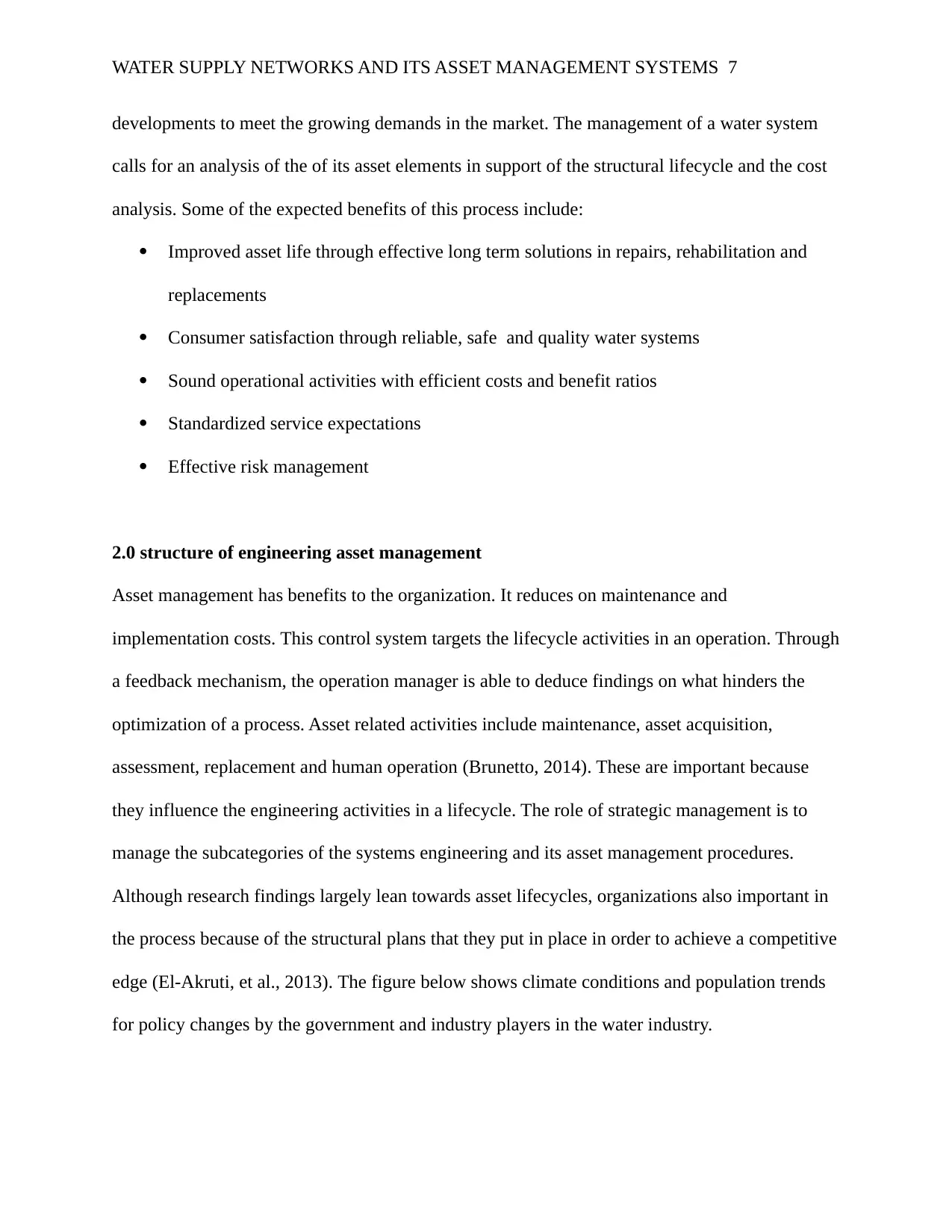
WATER SUPPLY NETWORKS AND ITS ASSET MANAGEMENT SYSTEMS 7
developments to meet the growing demands in the market. The management of a water system
calls for an analysis of the of its asset elements in support of the structural lifecycle and the cost
analysis. Some of the expected benefits of this process include:
Improved asset life through effective long term solutions in repairs, rehabilitation and
replacements
Consumer satisfaction through reliable, safe and quality water systems
Sound operational activities with efficient costs and benefit ratios
Standardized service expectations
Effective risk management
2.0 structure of engineering asset management
Asset management has benefits to the organization. It reduces on maintenance and
implementation costs. This control system targets the lifecycle activities in an operation. Through
a feedback mechanism, the operation manager is able to deduce findings on what hinders the
optimization of a process. Asset related activities include maintenance, asset acquisition,
assessment, replacement and human operation (Brunetto, 2014). These are important because
they influence the engineering activities in a lifecycle. The role of strategic management is to
manage the subcategories of the systems engineering and its asset management procedures.
Although research findings largely lean towards asset lifecycles, organizations also important in
the process because of the structural plans that they put in place in order to achieve a competitive
edge (El-Akruti, et al., 2013). The figure below shows climate conditions and population trends
for policy changes by the government and industry players in the water industry.
developments to meet the growing demands in the market. The management of a water system
calls for an analysis of the of its asset elements in support of the structural lifecycle and the cost
analysis. Some of the expected benefits of this process include:
Improved asset life through effective long term solutions in repairs, rehabilitation and
replacements
Consumer satisfaction through reliable, safe and quality water systems
Sound operational activities with efficient costs and benefit ratios
Standardized service expectations
Effective risk management
2.0 structure of engineering asset management
Asset management has benefits to the organization. It reduces on maintenance and
implementation costs. This control system targets the lifecycle activities in an operation. Through
a feedback mechanism, the operation manager is able to deduce findings on what hinders the
optimization of a process. Asset related activities include maintenance, asset acquisition,
assessment, replacement and human operation (Brunetto, 2014). These are important because
they influence the engineering activities in a lifecycle. The role of strategic management is to
manage the subcategories of the systems engineering and its asset management procedures.
Although research findings largely lean towards asset lifecycles, organizations also important in
the process because of the structural plans that they put in place in order to achieve a competitive
edge (El-Akruti, et al., 2013). The figure below shows climate conditions and population trends
for policy changes by the government and industry players in the water industry.
Paraphrase This Document
Need a fresh take? Get an instant paraphrase of this document with our AI Paraphraser
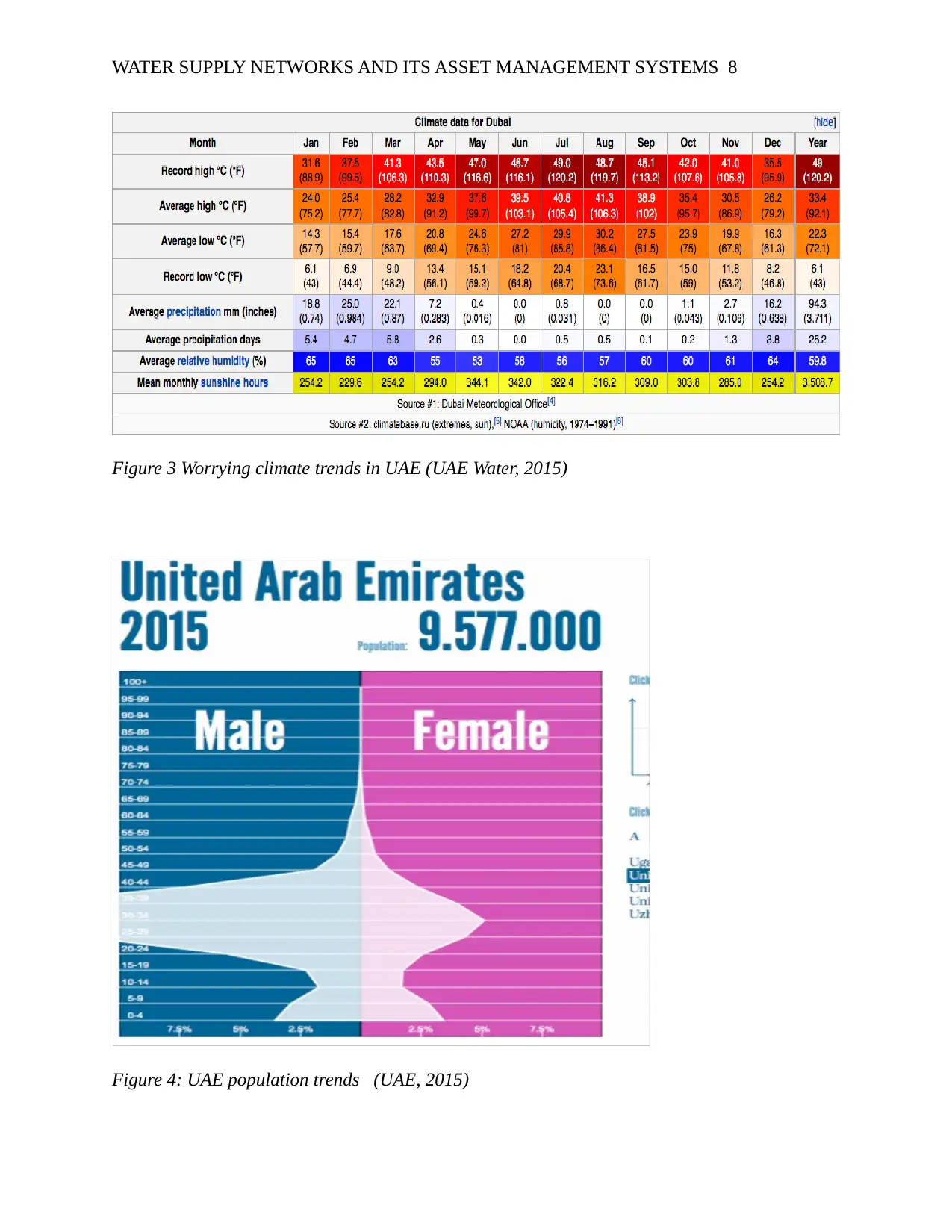
WATER SUPPLY NETWORKS AND ITS ASSET MANAGEMENT SYSTEMS 8
Figure 3 Worrying climate trends in UAE (UAE Water, 2015)
Figure 4: UAE population trends (UAE, 2015)
Figure 3 Worrying climate trends in UAE (UAE Water, 2015)
Figure 4: UAE population trends (UAE, 2015)
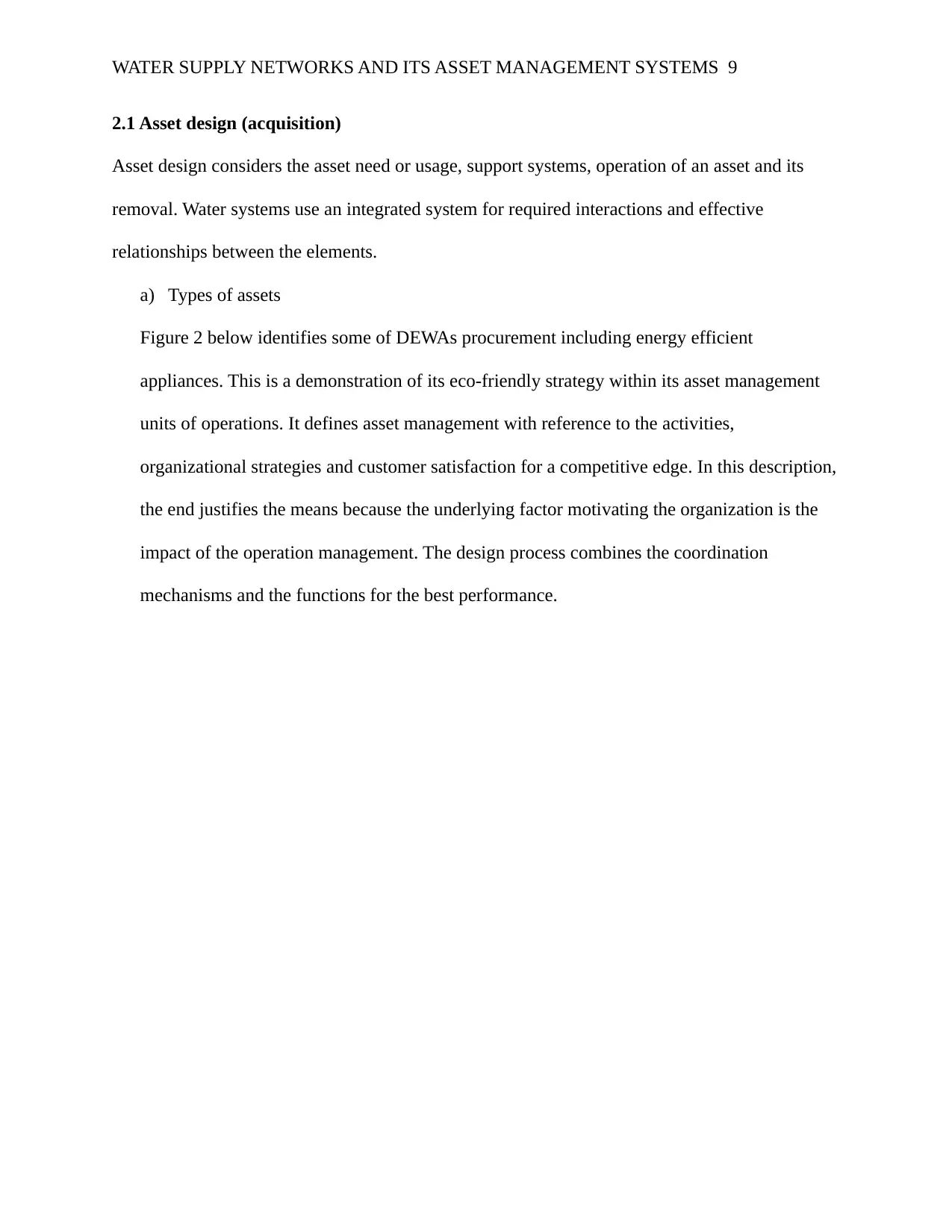
WATER SUPPLY NETWORKS AND ITS ASSET MANAGEMENT SYSTEMS 9
2.1 Asset design (acquisition)
Asset design considers the asset need or usage, support systems, operation of an asset and its
removal. Water systems use an integrated system for required interactions and effective
relationships between the elements.
a) Types of assets
Figure 2 below identifies some of DEWAs procurement including energy efficient
appliances. This is a demonstration of its eco-friendly strategy within its asset management
units of operations. It defines asset management with reference to the activities,
organizational strategies and customer satisfaction for a competitive edge. In this description,
the end justifies the means because the underlying factor motivating the organization is the
impact of the operation management. The design process combines the coordination
mechanisms and the functions for the best performance.
2.1 Asset design (acquisition)
Asset design considers the asset need or usage, support systems, operation of an asset and its
removal. Water systems use an integrated system for required interactions and effective
relationships between the elements.
a) Types of assets
Figure 2 below identifies some of DEWAs procurement including energy efficient
appliances. This is a demonstration of its eco-friendly strategy within its asset management
units of operations. It defines asset management with reference to the activities,
organizational strategies and customer satisfaction for a competitive edge. In this description,
the end justifies the means because the underlying factor motivating the organization is the
impact of the operation management. The design process combines the coordination
mechanisms and the functions for the best performance.
⊘ This is a preview!⊘
Do you want full access?
Subscribe today to unlock all pages.

Trusted by 1+ million students worldwide
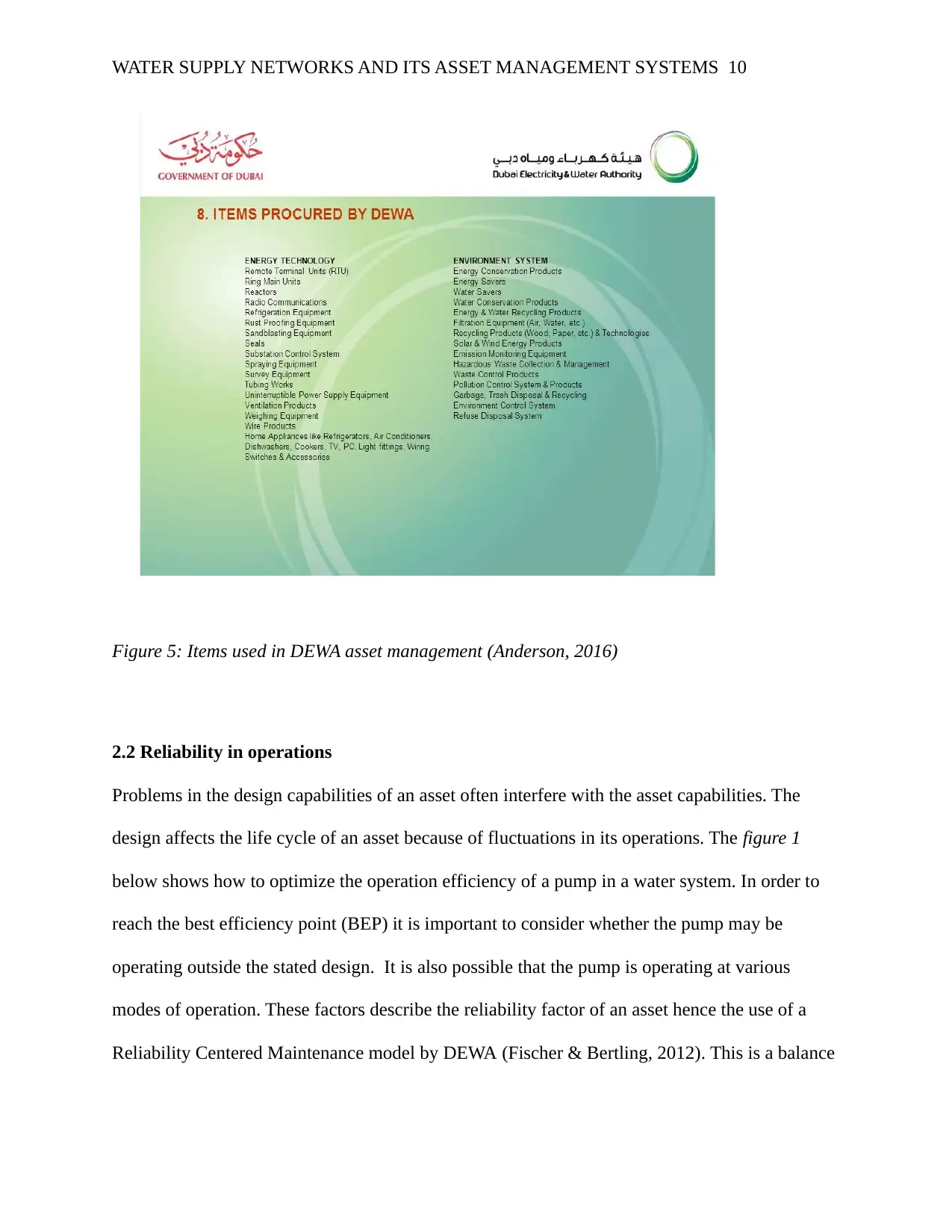
WATER SUPPLY NETWORKS AND ITS ASSET MANAGEMENT SYSTEMS 10
Figure 5: Items used in DEWA asset management (Anderson, 2016)
2.2 Reliability in operations
Problems in the design capabilities of an asset often interfere with the asset capabilities. The
design affects the life cycle of an asset because of fluctuations in its operations. The figure 1
below shows how to optimize the operation efficiency of a pump in a water system. In order to
reach the best efficiency point (BEP) it is important to consider whether the pump may be
operating outside the stated design. It is also possible that the pump is operating at various
modes of operation. These factors describe the reliability factor of an asset hence the use of a
Reliability Centered Maintenance model by DEWA (Fischer & Bertling, 2012). This is a balance
Figure 5: Items used in DEWA asset management (Anderson, 2016)
2.2 Reliability in operations
Problems in the design capabilities of an asset often interfere with the asset capabilities. The
design affects the life cycle of an asset because of fluctuations in its operations. The figure 1
below shows how to optimize the operation efficiency of a pump in a water system. In order to
reach the best efficiency point (BEP) it is important to consider whether the pump may be
operating outside the stated design. It is also possible that the pump is operating at various
modes of operation. These factors describe the reliability factor of an asset hence the use of a
Reliability Centered Maintenance model by DEWA (Fischer & Bertling, 2012). This is a balance
Paraphrase This Document
Need a fresh take? Get an instant paraphrase of this document with our AI Paraphraser
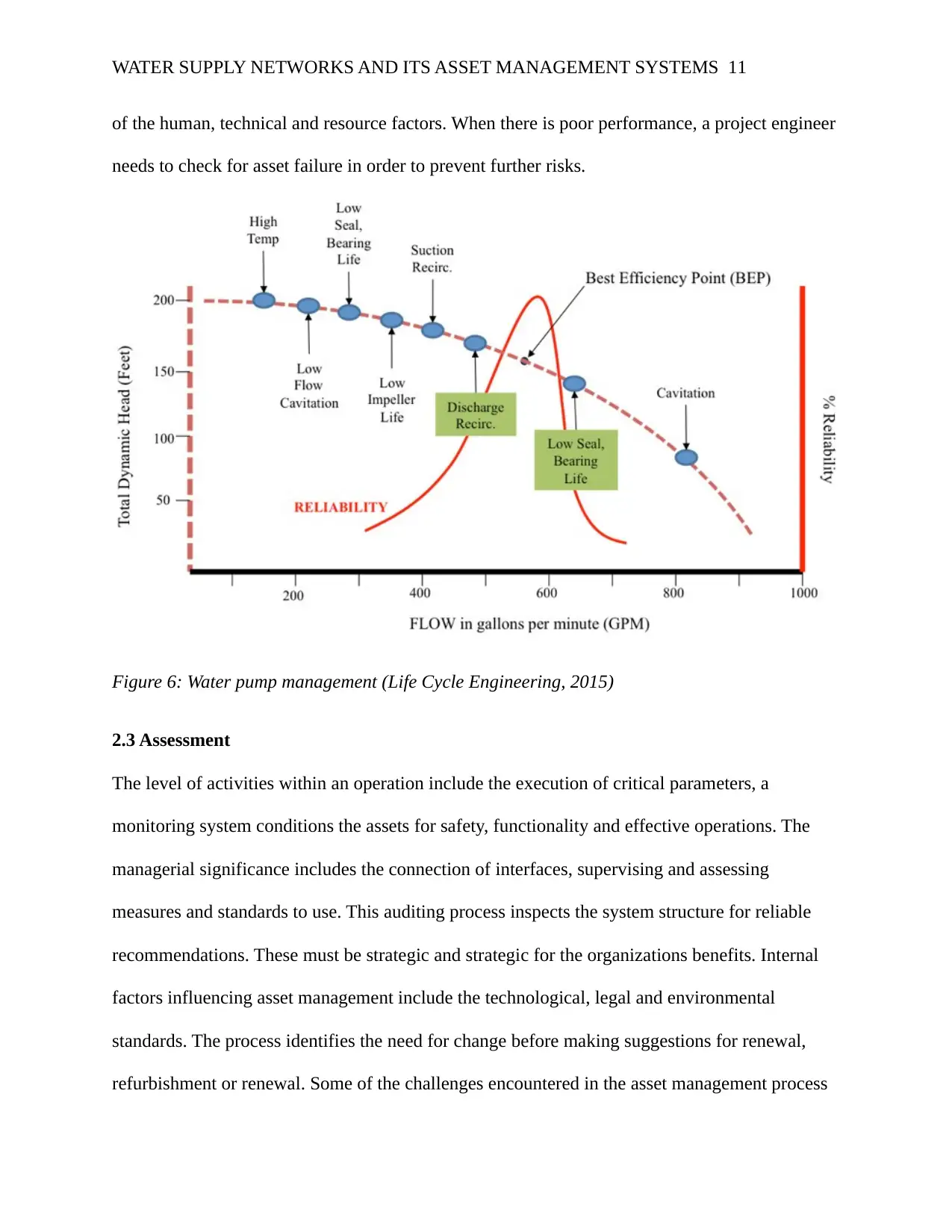
WATER SUPPLY NETWORKS AND ITS ASSET MANAGEMENT SYSTEMS 11
of the human, technical and resource factors. When there is poor performance, a project engineer
needs to check for asset failure in order to prevent further risks.
Figure 6: Water pump management (Life Cycle Engineering, 2015)
2.3 Assessment
The level of activities within an operation include the execution of critical parameters, a
monitoring system conditions the assets for safety, functionality and effective operations. The
managerial significance includes the connection of interfaces, supervising and assessing
measures and standards to use. This auditing process inspects the system structure for reliable
recommendations. These must be strategic and strategic for the organizations benefits. Internal
factors influencing asset management include the technological, legal and environmental
standards. The process identifies the need for change before making suggestions for renewal,
refurbishment or renewal. Some of the challenges encountered in the asset management process
of the human, technical and resource factors. When there is poor performance, a project engineer
needs to check for asset failure in order to prevent further risks.
Figure 6: Water pump management (Life Cycle Engineering, 2015)
2.3 Assessment
The level of activities within an operation include the execution of critical parameters, a
monitoring system conditions the assets for safety, functionality and effective operations. The
managerial significance includes the connection of interfaces, supervising and assessing
measures and standards to use. This auditing process inspects the system structure for reliable
recommendations. These must be strategic and strategic for the organizations benefits. Internal
factors influencing asset management include the technological, legal and environmental
standards. The process identifies the need for change before making suggestions for renewal,
refurbishment or renewal. Some of the challenges encountered in the asset management process
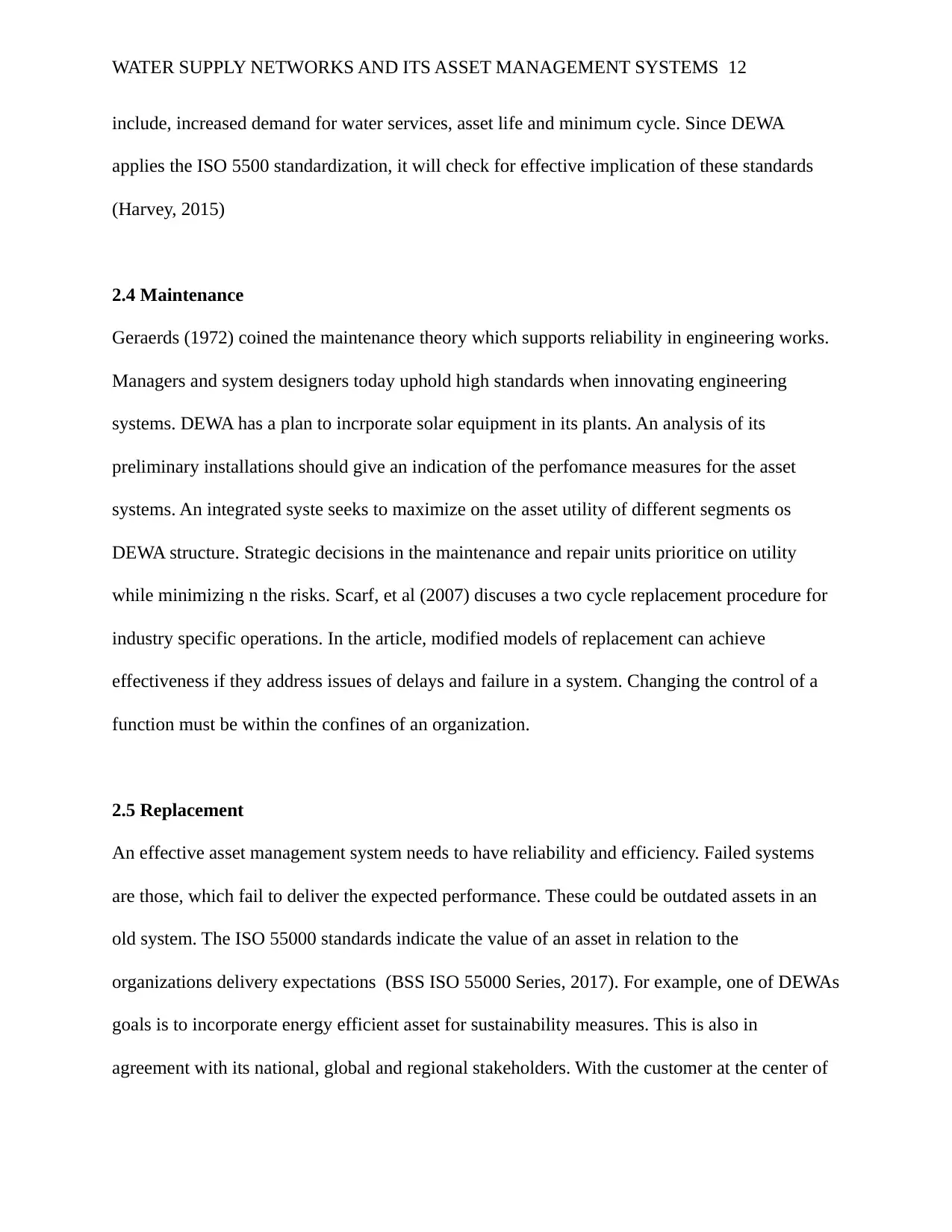
WATER SUPPLY NETWORKS AND ITS ASSET MANAGEMENT SYSTEMS 12
include, increased demand for water services, asset life and minimum cycle. Since DEWA
applies the ISO 5500 standardization, it will check for effective implication of these standards
(Harvey, 2015)
2.4 Maintenance
Geraerds (1972) coined the maintenance theory which supports reliability in engineering works.
Managers and system designers today uphold high standards when innovating engineering
systems. DEWA has a plan to incrporate solar equipment in its plants. An analysis of its
preliminary installations should give an indication of the perfomance measures for the asset
systems. An integrated syste seeks to maximize on the asset utility of different segments os
DEWA structure. Strategic decisions in the maintenance and repair units prioritice on utility
while minimizing n the risks. Scarf, et al (2007) discuses a two cycle replacement procedure for
industry specific operations. In the article, modified models of replacement can achieve
effectiveness if they address issues of delays and failure in a system. Changing the control of a
function must be within the confines of an organization.
2.5 Replacement
An effective asset management system needs to have reliability and efficiency. Failed systems
are those, which fail to deliver the expected performance. These could be outdated assets in an
old system. The ISO 55000 standards indicate the value of an asset in relation to the
organizations delivery expectations (BSS ISO 55000 Series, 2017). For example, one of DEWAs
goals is to incorporate energy efficient asset for sustainability measures. This is also in
agreement with its national, global and regional stakeholders. With the customer at the center of
include, increased demand for water services, asset life and minimum cycle. Since DEWA
applies the ISO 5500 standardization, it will check for effective implication of these standards
(Harvey, 2015)
2.4 Maintenance
Geraerds (1972) coined the maintenance theory which supports reliability in engineering works.
Managers and system designers today uphold high standards when innovating engineering
systems. DEWA has a plan to incrporate solar equipment in its plants. An analysis of its
preliminary installations should give an indication of the perfomance measures for the asset
systems. An integrated syste seeks to maximize on the asset utility of different segments os
DEWA structure. Strategic decisions in the maintenance and repair units prioritice on utility
while minimizing n the risks. Scarf, et al (2007) discuses a two cycle replacement procedure for
industry specific operations. In the article, modified models of replacement can achieve
effectiveness if they address issues of delays and failure in a system. Changing the control of a
function must be within the confines of an organization.
2.5 Replacement
An effective asset management system needs to have reliability and efficiency. Failed systems
are those, which fail to deliver the expected performance. These could be outdated assets in an
old system. The ISO 55000 standards indicate the value of an asset in relation to the
organizations delivery expectations (BSS ISO 55000 Series, 2017). For example, one of DEWAs
goals is to incorporate energy efficient asset for sustainability measures. This is also in
agreement with its national, global and regional stakeholders. With the customer at the center of
⊘ This is a preview!⊘
Do you want full access?
Subscribe today to unlock all pages.

Trusted by 1+ million students worldwide
1 out of 35
Related Documents
Your All-in-One AI-Powered Toolkit for Academic Success.
+13062052269
info@desklib.com
Available 24*7 on WhatsApp / Email
![[object Object]](/_next/static/media/star-bottom.7253800d.svg)
Unlock your academic potential
Copyright © 2020–2025 A2Z Services. All Rights Reserved. Developed and managed by ZUCOL.





